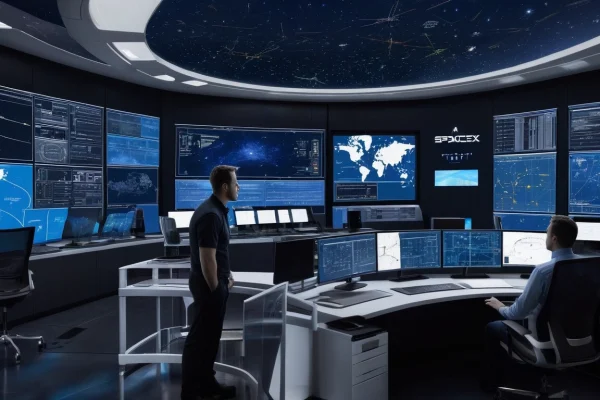Who Inspired the Growth of SpaceX?

- Who Inspired the Growth of SpaceX?
- Elon Musk: The Visionary Leader
- Influential Engineers and Scientists
- Collaborations with NASA
- Competitive Landscape: Other Space Companies
- Public Interest in Space Exploration
- Cultural Impact of Science Fiction
- Government Policies and Funding
- Global Collaboration in Space Exploration
- Frequently Asked Questions
When we think about the incredible journey of SpaceX, it’s hard not to marvel at the myriad of influences that have shaped its trajectory. From visionary leaders to groundbreaking collaborations, the growth of SpaceX is a tapestry woven from the threads of ambition, innovation, and collaboration. This article delves into the key figures and influences that have inspired this revolutionary company, revealing how each played a pivotal role in its success.
At the heart of SpaceX’s story is Elon Musk, a name synonymous with innovation and risk-taking. Musk’s bold vision for interplanetary travel and his relentless pursuit of making life multi-planetary have not only driven the company’s objectives but have also inspired a generation of dreamers and doers. His mantra, “If something is important enough, even if the odds are against you, you should still do it,” encapsulates the spirit of SpaceX and its mission.
But Musk isn’t the only star in this cosmic narrative. The talented engineers and scientists at SpaceX have been the unsung heroes, working tirelessly behind the scenes. Their expertise in aerospace technology has led to remarkable advancements in rocket design. For instance, the Falcon 9 rocket, a cornerstone of SpaceX’s fleet, showcases the ingenuity of these minds. The team’s commitment to excellence is evident in every launch, pushing the boundaries of what’s possible.
Moreover, collaborations with NASA have provided a significant boost to SpaceX’s growth. These partnerships have not only brought in vital funding but have also lent credibility to the company’s endeavors. Through initiatives like the Commercial Crew Program, SpaceX has achieved milestones that once seemed like science fiction, such as launching astronauts to the International Space Station.
Interestingly, the competitive landscape of the aerospace industry has also been a catalyst for SpaceX’s innovation. Rival companies push SpaceX to continuously improve its technologies, driving down costs and enhancing services. This healthy competition fosters a spirit of innovation that benefits everyone involved in space exploration.
Finally, the cultural impact of science fiction cannot be overlooked. From Star Trek to Interstellar, popular media has shaped public perception and aspirations for space travel. This cultural backdrop has motivated SpaceX to transform imaginative concepts into reality, making the dream of space travel accessible to the masses.
In summary, the growth of SpaceX is not just about one person or idea; it’s a collective effort influenced by visionary leaders, dedicated engineers, strategic collaborations, and a society eager to explore the cosmos. As we continue to watch SpaceX’s journey unfold, it’s clear that the inspiration behind it is as vast as the universe itself.
Elon Musk: The Visionary Leader
When you think of SpaceX, the name Elon Musk undoubtedly comes to mind. This man isn’t just a CEO; he’s a visionary leader whose dreams of interplanetary travel have inspired countless individuals. Musk’s ambition is akin to a rocket blasting off—powerful, exhilarating, and a little bit unpredictable. His relentless pursuit of innovation has set the tone for SpaceX, pushing the boundaries of what we believe is possible in space exploration.
Musk’s journey into the cosmos began with a simple but profound idea: to make space travel more affordable and accessible. He once famously said,
“I want to die on Mars, just not on impact.”
This quote encapsulates his passion and determination to revolutionize space travel. Under his leadership, SpaceX has achieved remarkable milestones, including the first privately-funded spacecraft to reach orbit and the first commercial spacecraft to deliver cargo to the International Space Station.
But what truly distinguishes Musk from other leaders is his ability to inspire a culture of innovation. He surrounds himself with a team of talented engineers and scientists who share his vision. Together, they work tirelessly to develop groundbreaking technologies, such as the Falcon 9 rocket and the Starship spacecraft. The synergy between Musk’s leadership and his team’s expertise creates a powerful engine of creativity and innovation.
| Key Achievements of SpaceX | Year |
|---|---|
| First privately-funded spacecraft to reach orbit | 2008 |
| First commercial spacecraft to deliver cargo to the ISS | 2012 |
| First reusable rocket to land successfully | 2015 |
| First private company to send astronauts to the ISS | 2020 |
Elon Musk’s vision is not just about reaching Mars; it’s about inspiring a new generation to dream big. He believes that humanity must become a multi-planetary species to ensure its survival. This bold perspective has captured the imagination of millions and has prompted a cultural shift towards space exploration. As we look to the stars, we owe much of this excitement to Musk’s indomitable spirit and visionary leadership.
Influential Engineers and Scientists
When we think about the phenomenal growth of SpaceX, it’s impossible to overlook the incredible contributions of its engineers and scientists. These talented individuals are the unsung heroes behind the scenes, transforming visionary ideas into tangible reality. Their expertise in aerospace technology and unwavering commitment to excellence have propelled SpaceX into the forefront of the space industry. Imagine a grand orchestra where each musician plays a vital role in creating a symphony; that’s how these engineers and scientists harmonize their skills to achieve remarkable breakthroughs in rocket design and manufacturing.
At the heart of SpaceX’s innovation is a team of brilliant minds, each bringing their unique skills and perspectives to the table. For instance, consider the work of Tom Mueller, the Vice President of Propulsion Engineering, who was instrumental in developing the engines that power the Falcon rockets. His deep understanding of rocket propulsion systems has been pivotal in enhancing the efficiency and reliability of SpaceX’s launch vehicles. As he once said, “The only way to do great work is to love what you do.” This passion resonates throughout the company, inspiring others to push the boundaries of what’s possible.
Moreover, the collaborative spirit within SpaceX fosters an environment where innovative ideas can flourish. The company encourages its engineers to challenge the status quo and think outside the box. This approach has led to groundbreaking technologies such as the reusable rocket system, which has fundamentally changed the economics of space travel. To illustrate the impact of these innovations, let’s take a look at the following table:
| Innovation | Impact |
|---|---|
| Reusable Rockets | Reduced launch costs significantly, making space more accessible. |
| Merlin Engines | Enhanced performance and reliability for Falcon 1, Falcon 9, and Falcon Heavy. |
| Starship Development | Aim for interplanetary travel, revolutionizing future space exploration. |
In conclusion, the at SpaceX are not just employees; they are pioneers reshaping the future of space exploration. Their relentless pursuit of innovation, combined with a collaborative culture, has created a powerhouse of creativity and technological advancement. As we look to the stars, it’s clear that these brilliant minds will continue to inspire generations to come.
Collaborations with NASA
When you think about the incredible journey of SpaceX, it’s hard to overlook the profound impact of its collaborations with NASA. These partnerships have not only provided essential funding but also offered invaluable resources and credibility that have propelled SpaceX to the forefront of the aerospace industry. Imagine trying to build a rocket without the backing of one of the most respected space agencies in the world—it’s like trying to bake a cake without flour!
The relationship between SpaceX and NASA began to blossom in the early 2000s, with both entities sharing a common goal: to push the boundaries of space exploration. NASA’s willingness to embrace private sector innovation has opened doors for SpaceX, allowing them to test and develop new technologies that might have taken years to achieve independently. This synergy has been crucial in achieving milestones such as the Commercial Crew Program, which aims to transport astronauts to the International Space Station (ISS).
| Collaboration Highlights | Year | Outcome |
|---|---|---|
| Commercial Crew Program | 2011 | Development of Crew Dragon spacecraft |
| COTS Program | 2006 | First commercial cargo delivery to ISS |
| Artemis Program | 2020 | Support for lunar missions |
Furthermore, NASA’s investment in SpaceX has served as a vote of confidence, attracting other investors and partners. The collaboration has also fostered a culture of innovation and excellence within SpaceX, as engineers and scientists work side by side with NASA experts. This exchange of knowledge is like a masterclass in rocket science, where both parties learn and grow together.
In conclusion, the collaborations with NASA have been a cornerstone of SpaceX’s success. They have not only provided the necessary support and resources but have also created a dynamic environment for innovation. As we look to the future of space exploration, it’s clear that this partnership will continue to inspire new generations of dreamers and doers.
Competitive Landscape: Other Space Companies
The competitive landscape of the aerospace industry is like a dynamic chess game, where each player must think several moves ahead. SpaceX, under the visionary leadership of Elon Musk, has not only positioned itself as a leader but has also been significantly influenced by the presence of other space companies. These rivals, ranging from established giants to innovative startups, challenge SpaceX to continuously push the boundaries of rocket technology and space exploration.
Companies such as Blue Origin, founded by Jeff Bezos, and Boeing, with its rich history in aerospace, create a vibrant ecosystem that fosters innovation. Each organization brings unique strengths and perspectives, compelling SpaceX to enhance its offerings. For instance, Blue Origin focuses on reusable rocket technology, which parallels SpaceX’s own innovations, encouraging both companies to improve efficiency and reduce costs.
| Company | Founder | Focus Area |
|---|---|---|
| SpaceX | Elon Musk | Reusable rockets, Mars colonization |
| Blue Origin | Jeff Bezos | Suborbital flight, reusable rockets |
| Boeing | William Boeing | Aerospace manufacturing, satellite technology |
| Virgin Galactic | Richard Branson | Commercial space tourism |
Moreover, the presence of these competitors has created a healthy competition that benefits not just the companies involved, but also the broader field of space exploration. As they vie for contracts, funding, and public interest, they inspire one another to innovate. This competitive drive is essential; it ensures that progress is not just incremental but exponential. How many breakthroughs have we seen simply because one company refused to be outdone by another?
In this thrilling race to the stars, the influence of other space companies cannot be underestimated. They are not just rivals; they are catalysts for improvement, pushing SpaceX to refine its technologies and expand its vision. As the landscape evolves, who knows what incredible advancements will emerge from this fierce competition?
Public Interest in Space Exploration
The growing public interest in space exploration has become a significant catalyst for SpaceX’s ambitious mission. As more individuals gaze up at the stars, dreaming about what lies beyond our planet, the enthusiasm for commercial space travel has surged. But what exactly has fueled this fascination? Is it the allure of the unknown, or perhaps the thrilling advancements in technology that make space travel seem more achievable than ever?
One of the most compelling aspects of this public interest is the way it intertwines with popular culture. Movies, books, and television shows have painted vivid pictures of space travel, igniting imaginations and inspiring a new generation of explorers. For instance, films like Interstellar and The Martian have not only entertained but also educated audiences about the possibilities of space exploration. This cultural phenomenon has created a ripple effect, encouraging people to support companies like SpaceX that are pushing the boundaries of what is possible.
Moreover, the rise of social media has allowed enthusiasts to connect and share their passion for space. Platforms like Twitter and Instagram are filled with stunning images of rockets, missions, and space phenomena, making the cosmos more accessible than ever. This digital engagement has led to an increase in public support and funding for space initiatives, as people rally around the idea of exploring the universe.
To illustrate the impact of public interest, consider the following table showcasing recent milestones in space exploration that captured the public’s imagination:
| Year | Milestone | Public Reaction |
|---|---|---|
| 2020 | SpaceX Crew Dragon Launch | Watched by millions, marking the return of human spaceflight from U.S. soil. |
| 2021 | Blue Origin’s New Shepard Flight | Massive media coverage and excitement about suborbital tourism. |
| 2023 | NASA’s Artemis I Mission | Revived interest in lunar exploration and future Mars missions. |
In conclusion, the is not just a passing trend; it’s a powerful force driving companies like SpaceX to innovate and expand their horizons. As we continue to witness breakthroughs in technology and an increasing number of missions, one can’t help but wonder: where will our curiosity take us next?

Cultural Impact of Science Fiction
The on SpaceX is nothing short of profound. For decades, science fiction has captured the imagination of people around the world, painting vivid pictures of interstellar travel, advanced technologies, and the potential for human life beyond Earth. This genre has not only entertained us but has also inspired a generation of innovators, including the brilliant minds at SpaceX. Just think about it: how many of us grew up dreaming of flying to Mars or living in a space colony? Those dreams are now being turned into reality!
One of the most significant ways science fiction has influenced SpaceX is through its ability to shape public perception. Iconic works like Arthur C. Clarke’s “2001: A Space Odyssey” and Isaac Asimov’s “Foundation” series have set the stage for what space exploration could look like. These stories have instilled a sense of wonder and possibility, encouraging both the public and investors to support ambitious projects like those of SpaceX.
Moreover, the technology depicted in science fiction often serves as a blueprint for real-world innovations. For instance, the concept of reusable rockets, which is a cornerstone of SpaceX’s business model, can be traced back to the imaginative tales of the past. The visionary ideas presented in these narratives have provided a fertile ground for engineers and scientists to cultivate groundbreaking solutions.
| Influential Science Fiction Works | Key Concepts |
|---|---|
| 2001: A Space Odyssey | Artificial Intelligence, Space Travel |
| The Martian | Colonization of Mars, Survival Technology |
| Foundation Series | Galactic Empires, Predictive Science |
In addition to inspiring technology, science fiction has also fostered a community of enthusiasts who advocate for space exploration. The growing fan base has led to increased funding and support for organizations like SpaceX. As the public’s interest in the cosmos expands, so does the pressure on companies to innovate and deliver on the dreams that science fiction has sparked.
Ultimately, the on SpaceX is a testament to the power of imagination. It serves as a reminder that the boundaries of what is possible are often defined by our dreams. As we continue to explore the universe, we must not forget the stories that inspired us to reach for the stars.
Government Policies and Funding
The role of in the growth of SpaceX cannot be overstated. In a field as complex and costly as aerospace, having the right support can make all the difference. From the very beginning, SpaceX benefited from a favorable regulatory environment that encouraged innovation and investment. This support has been crucial in allowing the company to take bold steps toward its ambitious goals in space exploration.
One of the most significant contributions from the government has been through various funding initiatives. For instance, NASA’s Commercial Crew Program provided SpaceX with substantial financial backing to develop its Crew Dragon spacecraft. This partnership not only offered necessary capital but also lent the company credibility, which is invaluable in the competitive aerospace sector. The table below outlines some key government programs that have supported SpaceX:
| Government Program | Type of Support | Impact on SpaceX |
|---|---|---|
| NASA’s Commercial Crew Program | Funding and Resources | Development of Crew Dragon spacecraft |
| Space Act Agreements | Collaboration and Innovation | Access to NASA facilities and expertise |
| National Space Policy | Regulatory Support | Encouragement of private sector involvement |
Moreover, favorable government policies have encouraged private investment in the space sector. As a result, many venture capitalists are eager to fund innovative companies like SpaceX. This influx of private capital has allowed SpaceX to accelerate its development timelines and expand its operational capabilities.
To sum it up, the intersection of supportive government policies and strategic funding initiatives has played a pivotal role in SpaceX’s journey. Without this backing, the company might not have achieved the remarkable milestones it has today. The collaborative spirit between SpaceX and government entities illustrates how public and private sectors can work together to push the boundaries of what’s possible in space exploration.
Global Collaboration in Space Exploration
The world of space exploration is no longer confined to a single nation or organization. Global collaboration has become a cornerstone of advancements in this field, and SpaceX stands at the forefront of this movement. By partnering with various international agencies and companies, SpaceX has expanded its reach and capabilities, paving the way for a new era of exploration. Imagine a tapestry woven from the threads of different cultures, technologies, and ideas, all coming together to push the boundaries of what we know about the universe.
One of the most remarkable aspects of SpaceX’s global collaborations is its partnerships with agencies like the European Space Agency (ESA) and the Japanese Aerospace Exploration Agency (JAXA). These alliances have not only fostered technological exchange but have also enriched SpaceX’s understanding of different approaches to space challenges. For instance, the collaboration with NASA on the Commercial Crew Program exemplifies how shared goals can lead to monumental achievements, such as sending astronauts to the International Space Station (ISS).
Moreover, the global landscape of space exploration has seen the emergence of various private companies that are eager to collaborate with SpaceX. These partnerships are often driven by the need to share resources, knowledge, and funding, which can significantly reduce the costs associated with space missions. A prime example is the partnership between SpaceX and international satellite companies, which allows for the sharing of satellite launch services and technology.
Here’s a brief overview of some key international partnerships that have bolstered SpaceX’s capabilities:
| Partner | Contribution |
|---|---|
| NASA | Funding and technology exchange for crewed missions |
| ESA | Collaboration on satellite technology and research |
| JAXA | Joint missions and technology sharing |
In addition to these partnerships, the growing interest in space exploration among countries worldwide has led to a more collaborative environment. Nations are recognizing that space is a shared frontier, and working together can yield greater benefits. As we continue to explore the cosmos, the importance of global collaboration in space exploration cannot be overstated. It is through these alliances that we will unlock the mysteries of the universe and perhaps even discover new worlds.
Frequently Asked Questions
- Who is the primary inspiration behind SpaceX?
The primary inspiration behind SpaceX is Elon Musk. His visionary approach and relentless drive for innovation have been fundamental in shaping the company’s goals and culture.
- How have engineers and scientists influenced SpaceX?
Talented engineers and scientists at SpaceX have made significant contributions by applying their expertise in aerospace technology, which has led to remarkable advancements in rocket design and manufacturing.
- What role does NASA play in SpaceX’s success?
NASA has been a crucial partner for SpaceX, providing essential funding, resources, and credibility. This collaboration has enabled SpaceX to achieve groundbreaking milestones in space exploration.
- How does competition affect SpaceX?
The competitive landscape of the aerospace industry drives SpaceX to innovate continuously. Rival companies push them to enhance technologies, lower costs, and improve services, fostering a spirit of healthy competition.
- Why is public interest important for SpaceX?
Growing public interest in space exploration fuels SpaceX’s mission. As fascination with the cosmos increases, so does the demand for commercial space travel and satellite technology, propelling the company’s growth.
- How does science fiction impact SpaceX?
Science fiction has significantly inspired SpaceX’s vision. Popular media shapes public perception and aspirations for space travel, motivating the company to turn imaginative concepts into reality through technology.
- What government support does SpaceX receive?
Supportive government policies and funding initiatives have been vital for SpaceX. Favorable regulations and financial backing allow the company to take bold steps in advancing its space missions and infrastructure.
- How does global collaboration benefit SpaceX?
International partnerships expand SpaceX’s influence by providing access to diverse expertise, resources, and markets, enhancing its capabilities and reach within the space industry.





